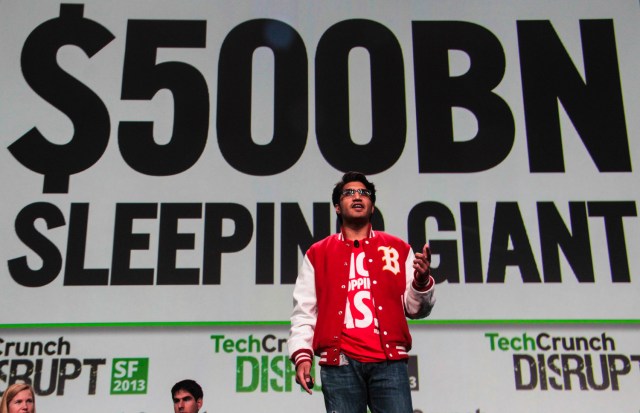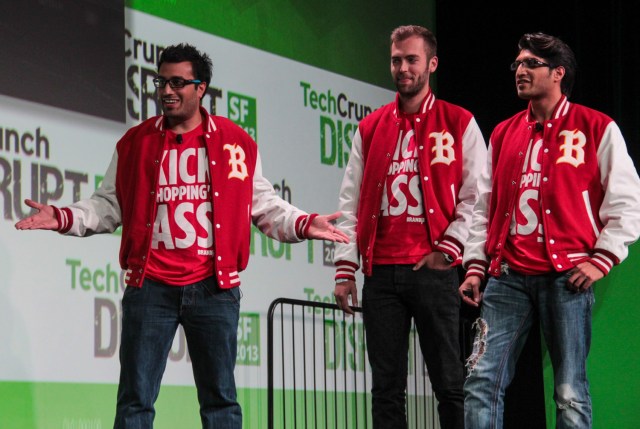BRANDiD, a personal shopping site that presented today on the TechCrunch Disrupt Battlefield stage, is hoping to catch the eye of that particular demographic of men who would rather do anything else in the world than shop for clothes. Founded in early 2012, the site helps guys outsource this task to personal shoppers, who can pull clothing recommendations from any e-commerce site they want.
Originally London-based but now located in San Francisco, BRANDiD was founded by brothers Ankush and Arush Sehgal and Nicolas Kermarc, the CEO and engineers, respectively. The company won Seedcamp London that year and received $175,000 in funding. They are currently raising a seed round, the amount of which the team declined to disclose.
“We did all our alpha testing back home [in London] which is a notoriously difficult market to crack,” Ankush said. “When we began to show real traction there that’s when we knew we were ready to take on the US market.”
BRANDiD is currently available only in San Francisco and by invitation in order to balance supply and demand and ensure customer service, Arush said. The company will be releasing an iOS app later this year and looking to make hires in technical and community positions.
While a number of men’s e-commerce sites focus on customers who know fashion, BRANDiD is targeting the average Joe, who wants to look good but doesn’t really know how to get himself there. Converting that demographic into BRANDiD customers means making shopping ridiculously simple, from the selection process to the returns.
With personalization as the hot button topic in e-commerce, BRANDiD represents a subset of startups betting on a mix of data and human advice to keep customers coming back, rather than the solely algorithm-based recommendations that have become ubiquitous on other sites.
There are a number of good reasons to do so: data points won’t create an outfit that sings as well as a human eye does, and people are a more compelling sales force, especially when you grow to trust them. For those used to shopping offline, interacting with a salesperson is the most natural way to shop.
For those reasons, and the all-important laziness factor, BRANDiD is working hard to build a model with conversation at its core.
“It’s completely designed around the conversation. We threw away what we knew about e-commerce and completely focused on the conversation, which is live chat,” Ankush said.
On entering the site, customers go through an onboarding process powered by “M.A.L.E.” (BRANDiD’s Masculine Algorithmic Learning Engine). They answer multiple choice questions about their clothing preferences and check a “hit list” of clothing items that they need. That data is used to match the consumer to a shopper who best suits his style.
From there, the customer is put directly in touch with their “S.W.A.T.”(Specialist Wardrobe Augmentation Technician), and the two can connect over Facebook to talk about their options. When BRANDiD’s app launches later this year, it will include in-app messaging for S.W.A.Ts and their clients.
BRANDiD is looking to make itself especially appealing on returns, one-upping the free-shipping-label-included model that e-commerce sites like Asos to Warby Parker use to make things easy on their customers. Starting in San Francisco, BRANDiD will come pick clothing items up if they don’t work out, no paperwork needed. Want to leave it with the doorman at your office building? Totally cool.
With the tag line, “Kick shopping’s ass,” BRANDiD is going for a decidedly bro-friendly vibe. An onboarding question asks, “Who would win in a fight?” between Harry Potter and Tony Montana. The correct answer is Montana.
The site has a lot of personality, and it isn’t for everyone, the founders said. But those who like it will like it a lot, and they would rather build a smaller base of rabid fans than try to appeal to everyone.
“E-commerce traditionally was for women. They like to shop, learn about fashion, and they’re on the site longer,” Ankush said. “With guys this doesn’t work at all. If you look at the Gilt Man blog, there are zero comments on it every day. Everyone else was going after this fashionista guy, but from our experience in retail and serving men, we really know that when it comes to shopping what they’re interested in is they want to get their stuff and get the fuck out.”
BRANDiD also shooting to capture the vast majority of men who still shop in stores as they make the transition to online shopping.
“If you think about it, it’s an absolutely enormous market,” Ankush said. “The 93% of men who shop in stores, over the next five years, that is really going to shift online. Everyone knows about the death of retail. I’ve been in retail and experienced it firsthand. To make it a successful retail business, as That 93% is going to shift to more where women’s is. There’s a massive opportunity there. Those guys that shop will be shopping online. They need something that is made for them.”
S.W.A.T.s, who are selected by application, earn money on a 10% surcharge automatically added to purchases. Because many men shop in bulk a few times a year, the average tip comes out to a rate of about $20 to $30 per hour spent shopping. It’s enough to make for a good part time job, and BRANDiD is reaching out to local fashion schools like San Francisco’s Fashion Institute of Design and Marketing (FIDM) to find sartorially inclined candidates.
The personal shoppers can add products from any online retailer and customers buy through BRANDiD, meaning the site owns the credit card and the customer. Down the road BRANDiD aims to secure affiliate style deals with online retailers, a goal that the team sees as highly achievable given that the sale is a done deal once the customer has given the ok to an item of clothing. With e-commerce sites that simply forward the consumer to another retailer, there’s a good chance that the cart will get dropped somewhere along the way.
“We’re selling the retailers a guaranteed sale. It’ll take time for the industry to figure out what to do with that.”
Question & Answer
Q. You have a background in men’s fashion. There seem to be so many shopping sites. What’s special about yours? Is it the shopper? Are they incentivized by tips?
A. What differentiates us is two things: we live and die by our community, and the shopper is a unique thing about us. We have an amazing array of people working with us. The second thing is our try before you buy it feature. We’re anti-fashion tech.
Q. How are you going to scale labor?
A. Our shoppers are also the people who, when they’re not shopping, do collection. Very similar to Lyft, our shoppers come through recommendations.
Q. Are you starting in a particular city?
A. It’s San Francisco only right now. We need to scale supply and demand in an equal ratio. Rolling out city by city.
Q. So your shopper needs to love shopping but also drive around city all day…
A. It’s certainly up to you.
Q. Sounds labor intensive. How do you scale?
A. We’ve done retail and e-commerce, and one thing we’ve always wanted to avoid was logistics. What we do allows us to scale because of those reasons. Our distribution is distributed by shoppers. We never touch stock.

